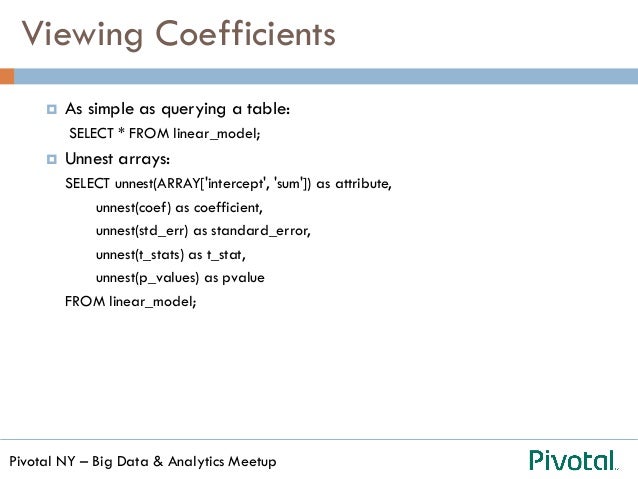Unnest Sql | Sql multiple unnest en la list de selección única. Shared one demonstration of unnest() with ordinality feature of postgresql 9.4 which is used to generate sequence for string array. One powerful sql pattern is to make an array of structs and then unnest. Currently, the sql for the with clause will be inlined anywhere the named relation is used. If there are multiple ordinary array arguments specified, the number of rows will match the array with.
If there are multiple ordinary array arguments specified, the number of rows will match the array with. I am trying to achieve something like left join with array unnest() function. Currently, the sql for the with clause will be inlined anywhere the named relation is used. I want the query to return a. It is extremely helpful when working with arrays.
If there are multiple ordinary array arguments specified, the number of rows will match the array with. Using these three in combination also makes some kinds of queries much, much easier to write. You can then join your original row against each unnested. I want the query to return a. Sql multiple unnest en la list de selección única. This function is used to expand an array to a set of rows. It is extremely helpful when working with arrays. Without feature s301, enhanced unnest, in conforming sql language, a <collection derived table> shall not simply contain more than one <collection value expression>. Create or replace function unnest(anyarray). Currently, the sql for the with clause will be inlined anywhere the named relation is used. Connect and share knowledge within a single location that is structured and easy to search. The oracle query optimizer has basically two types of transformations at its disposal: Create function unnest2(anyarray) returns setof record as $body$ select $1i, i from generate_series(array_lower($1,1), array_upper($1,1)) i;
This video shows an example in an. The sql standard defines the unnest function to return a result table with one row for each element of an array. Without feature s301, enhanced unnest, in conforming sql language, a <collection derived table> shall not simply contain more than one <collection value expression>. In this tutorial we have shown what is unnest function in sql script and how to use unnest function in procedure. Postgresql 8.4 includes a function for expanding any array of any dimension into a set of elements.

Shared one demonstration of unnest() with ordinality feature of postgresql 9.4 which is used to generate sequence for string array. You can then join your original row against each unnested. If there are multiple ordinary array arguments specified, the number of rows will match the array with. Using these three in combination also makes some kinds of queries much, much easier to write. I want the query to return a. The sql standard defines the unnest function to return a result table with one row for each element of an array. Connect and share knowledge within a single location that is structured and easy to search. The oracle query optimizer has basically two types of transformations at its disposal: Postgresql 8.4 includes a function for expanding any array of any dimension into a set of elements. Definition, syntax, examples and common errors using bigquery standard sql. It basically lets you take elements in an array and expand each one of these individual elements. Manual implementation of unnest() function from postgresql 8.4, for use in postgresql < 8.4. Quiero poder usar la function unnest() en postgresql en una consulta sql complicada que tiene muchos join.
Postgresql 8.4 includes a function for expanding any array of any dimension into a set of elements. One powerful sql pattern is to make an array of structs and then unnest. The unnest function takes an array and returns a table with a row for each element in the array. Connect and share knowledge within a single location that is structured and easy to search. Subquery unnesting unnests and merges the body of the subquery into the body of the query oracle database sql reference for more information on unnesting nested subqueries and the.

Subquery unnesting unnests and merges the body of the subquery into the body of the query oracle database sql reference for more information on unnesting nested subqueries and the. Shared one demonstration of unnest() with ordinality feature of postgresql 9.4 which is used to generate sequence for string array. This function is used to expand an array to a set of rows. The unnest function takes an array and returns a table with a row for each element in the array. Sql multiple unnest en la list de selección única. Currently, the sql for the with clause will be inlined anywhere the named relation is used. Quiero poder usar la function unnest() en postgresql en una consulta sql complicada que tiene muchos join. Postgresql 8.4 includes a function for expanding any array of any dimension into a set of elements. How to work with nested data in bigquery. If there are multiple ordinary array arguments specified, the number of rows will match the array with. Connect and share knowledge within a single location that is structured and easy to search. In this tutorial we have shown what is unnest function in sql script and how to use unnest function in procedure. I want the query to return a.
The oracle query optimizer has basically two types of transformations at its disposal: unnest. I want the query to return a.
Unnest Sql: You can then join your original row against each unnested.


0 comments